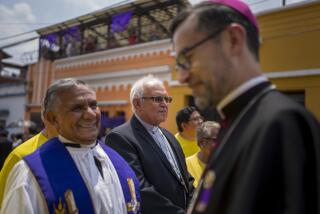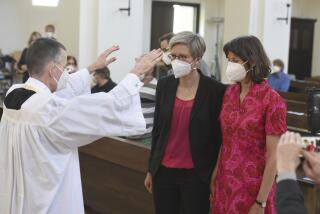Peru’s Priests Married, With Children
- Share via
HUANCAYO, Peru — Jose Zarate was eating breakfast with his wife and three children in their home in this Andean city when the telephone rang. A merchant wanted him to bless his new medical supplies shop.
Packing his Bible, crucifix and holy water in a black case, Zarate headed off to carry out his priestly duties in the poor mountain community 120 miles east of Lima.
The wiry 72-year-old is one of dozens of married men officially stripped of their priesthoods and parishes by the Roman Catholic Church, but who continue giving services in the Andes mountains in a widely accepted outlaw priesthood.
The defrocked priests say they are only being open about a practice not uncommon among Catholic priests in Peru.
Zarate estimates that more than 80% of priests in Peru have wives, and often children. Some American priests working in Peru put the figure closer to one in two--still among one of the highest rates in the world, they say.
“Almost all priests in the Andes have families, but they are forced to hide them,” Zarate said. “It’s time for the Catholic hierarchy to end the hypocrisy and make the celibacy of its priests optional.”
Church leaders acknowledge the centuries-old tradition of non-celibacy in Peru but say they are working to end it by easing the isolation of priests in remote communities and supervising them more.
“Before, the priests were almost completely abandoned by the church--their bishop visited them once every 10 years--but the new mentality is to visit them more often,” said Archbishop Albano Quinn of Sicuani in the Andean department of Cuzco. Quinn backs the church’s celibacy position.
Priests face extraordinary pressures to form families in Peru’s Andean communities, which often see celibacy as unnatural, said the Rev. Thomas Garr, an American Jesuit priest who has worked in Peru for 25 years.
Taking a wife is seen as proof of male adulthood. Without one, a man has great difficulty being taken seriously by Andean people, Garr said.
Added to the social pressure are the years of loneliness and isolation from the community of priests, he said.
“When I arrived in my Andean parish, people asked me why I didn’t have a woman,” said Garr, who is not married. “They joked that they hoped I didn’t take any of their wives, I guess because it had happened in the past.”
Most Andean Indian communities, which were forcibly converted by the Spanish invaders, are devoutly Catholic but have never incorporated all church doctrine; they mix in local beliefs, anthropologists say.
In Peru’s ancient Inca and Aymara cultures, the holy men had families, and celibacy is still not fully accepted by those communities today, said Federico Kauffman-Doig, a Peruvian archeologist.
Kauffman-Doig, whose great-grandfather was a priest with 10 children, has traveled the Andes in search of ruins for decades. He often sleeps in the local priest’s house when there is no hotel.
Most of the priests he has stayed with have had families, he said. “They’ll say the children in the house are nieces and nephews, and that the women are cousins.”
The church ban on marriage sometimes leads priests to deny or abandon children, married priests charge. In the Andes, the expression “son of a priest” is used to denote someone who is denied his fair share.
Although the tradition of non-celibate priests is strongest in Peru, it exists across Latin America.
The Latin American Assn. of Married Priests has chapters in 11 countries, said former Argentine Bishop Geronimo Podesta, a member of the association.
“The problem of staying celibate is especially difficult for priests in Andean countries, and in parts of Africa, where the man without a family has a low social status,” Podesta said.
The group wants the Catholic hierarchy to make celibacy optional, arguing the restriction is not demanded in the Bible and is not feasible in some regions.
The church has required celibacy for priests since the 11th century, before which time it was permissible for them to marry.
Zarate’s wife of 30 years, Julia Bernuy, said she initially had doubts about her husband’s married-priest status, fearing rejection by the community.
“But when I saw that people needed him, I came to support his work,” she said.
Married men as priests aren’t universally accepted in the Andes.
“A priest’s family is the people of God; he can’t have his own family. I came to this service without knowing the priest was married and wouldn’t have come if I had,” Domitila Rodriguez, a 34-year-old teacher, said after attending a Mass celebrated by married priest David Camayo.
Others admire the men’s honesty or think their marital status simply doesn’t matter.
“It’s better that a priest marry and have a family than keep a woman hidden somewhere, as commonly happens,” said farmer Jorge Medina.
More to Read
Sign up for Essential California
The most important California stories and recommendations in your inbox every morning.
You may occasionally receive promotional content from the Los Angeles Times.










